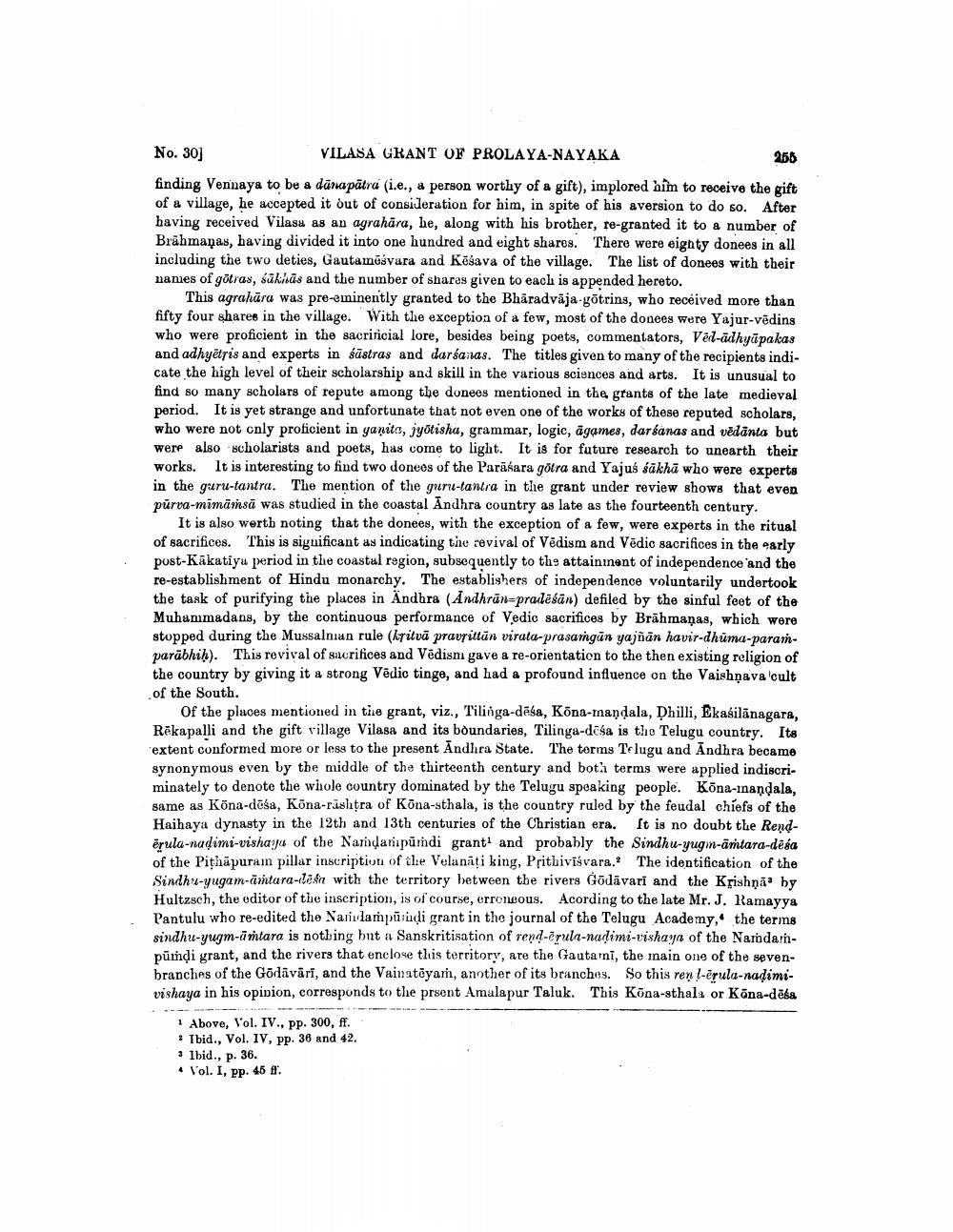________________
No. 30]
VILASA GRANT OF PROLAYA-NAYAKA
255
finding Vennaya to be a danapatra (i.e., a person worthy of a gift), implored him to receive the gift of a village, he accepted it out of consideration for him, in spite of his aversion to do so. After having received Vilasa as an agrahara, he, along with his brother, re-granted it to a number of Brahmanas, having divided it into one hundred and eight shares. There were eighty donees in all including the two deties, Gautamesvara and Kesava of the village. The list of donees with their names of götras, sākās and the number of shares given to each is appended hereto.
This agrahara was pre-eminently granted to the Bharadvaja götrins, who received more than fifty four shares in the village. With the exception of a few, most of the donees were Yajur-vēdins who were proficient in the sacrificial lore, besides being poets, commentators, Ved-adhyapakas and adhyetris and experts in sustras and darśanas. The titles given to many of the recipients indicate the high level of their scholarship and skill in the various sciences and arts. It is unusual to find so many scholars of repute among the donees mentioned in the grants of the late medieval period. It is yet strange and unfortunate that not even one of the works of these reputed scholars, who were not only proficient in ganito, jyotisha, grammar, logic, āgames, darśanas and vēdānta but were also scholarists and poets, has come to light. It is for future research to unearth their works. It is interesting to find two donees of the Parasara götra and Yajuś śākha who were experts in the guru-tantra. The mention of the guru-tantra in the grant under review shows that even pūrva-mimāmsā was studied in the coastal Andhra country as late as the fourteenth century.
It is also worth noting that the donees, with the exception of a few, were experts in the ritual of sacrifices. This is significant as indicating the revival of Vēdism and Vedic sacrifices in the early post-Kakatiya period in the coastal region, subsequently to the attainment of independence and the re-establishment of Hindu monarchy. The establishers of independence voluntarily undertook the task of purifying the places in Andhra (Andhrān=pradēśān) defiled by the sinful feet of the Muhammadans, by the continuous performance of Vedic sacrifices by Brahmanas, which were stopped during the Mussalmian rule (kritvā pravrittän virata-prasaṁgān yajñān havir-dhuma-paramparābhih). This revival of sacrifices and Vedism gave a re-orientation to the then existing religion of the country by giving it a strong Vedic tinge, and had a profound influence on the Vaishnava cult of the South.
Of the places mentioned in the grant, viz., Tilinga-desa, Kōna-mandala, Dhilli, Ekaśilānagara, Rekapalli and the gift village Vilasa and its boundaries, Tilinga-desa is the Telugu country. Its extent conformed more or less to the present Andhra State. The terms Telugu and Andhra became synonymous even by the middle of the thirteenth century and both terms were applied indiscriminately to denote the whole country dominated by the Telugu speaking people. Kōna-inandala, same as Kōna-desa, Kōna-rashtra of Kōna-sthala, is the country ruled by the feudal chiefs of the Haihaya dynasty in the 12th and 13th centuries of the Christian era. It is no doubt the Renderula-nadimi-vishaya of the Namḍampumdi grant1 and probably the Sindhu-yugm-āmtara-dē sa of the Pithapuram pillar inscription of the Velanați king, Prithiviśvara. The identification of the Sindhu-yugam-amtara-desa with the territory between the rivers Godavari and the Krishna by Hultzsch, the editor of the inscription, is of course, erroneous. Acording to the late Mr. J. Ramayya Pantulu who re-edited the Nanilampusudi grant in the journal of the Telugu Academy, the terms sindhu-yugm-amtara is nothing but a Sanskritisation of rend-erula-nadimi-vishaya of the Namdampumḍi grant, and the rivers that enclose this territory, are the Gautami, the main one of the sevenbranches of the Gōdāvārī, and the Vainatoyam, another of its branches. So this ren l-erula-nadimivishaya in his opinion, corresponds to the prsent Amalapur Taluk. This Kōna-sthala or Kōna-desa
1 Above, Vol. IV., pp. 300, ff.
2 Ibid., Vol. IV, pp. 36 and 42.
Ibid., p. 36.
Vol. I, pp. 45 ff.




